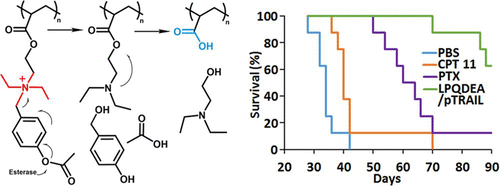当前位置:
X-MOL 学术
›
Biomacromolecules
›
论文详情
Our official English website, www.x-mol.net, welcomes your feedback! (Note: you will need to create a separate account there.)
Enzyme-Responsive Charge-Reversal Polymer-Mediated Effective Gene Therapy for Intraperitoneal Tumors
Biomacromolecules ( IF 6.2 ) Pub Date : 2018-05-08 00:00:00 , DOI: 10.1021/acs.biomac.8b00440 Nasha Qiu 1, 2 , Jianqing Gao 1 , Qi Liu 3 , Jinqiang Wang 2 , Youqing Shen 2
Biomacromolecules ( IF 6.2 ) Pub Date : 2018-05-08 00:00:00 , DOI: 10.1021/acs.biomac.8b00440 Nasha Qiu 1, 2 , Jianqing Gao 1 , Qi Liu 3 , Jinqiang Wang 2 , Youqing Shen 2
Affiliation

|
Gene therapy has demonstrated effectiveness in many genetic diseases, as evidenced by recent clinical applications. Viral vectors have been extensively tested in clinical gene-therapy trials, but nonviral vectors such as cationic polymers or lipids are much less used due to their lower gene-transfection efficiencies. However, the advantages of nonviral vectors, such as easily tailored structures, nonimmunogenetics, and relatively low cost, still drive great efforts to improve their transfection efficiencies. A reverse question asks if nonviral vectors with current gene transfection efficiency can find application niches. Herein, we synthesized a cationic polymer, poly{N-[2-(acryloyloxy)ethyl]-N-[p-acetyloxyphenyl]-N,N-diethylammonium chloride} (PQDEA), as a gene-delivery carrier and compared it side by side with chemotherapy drugs for cancer treatment. PQDEA is rapidly hydrolyzed by intracellular esterases into anionic poly(acrylic acid) to give low cytotoxicity and fast release of DNA for expression. PQDEA formed stable complexes with DNA (PQDEA/DNA polyplexes), which were further coated with a lipid layer to make serum-stable lipidic polyplexes, LPQDEA/DNAs, for in vivo use. In an intraperitoneal tumor xenograft model mimicking late-stage metastatic cervical cancer, the LPQDEA/DNA vector with TRAIL suicide gene exerted strong tumor inhibition as effective as paclitaxel, the first-line anticancer drug, but gave much less tumor relapse and much longer survival than the clinical chemotherapy drugs, irinotecan and paclitaxel. Equally important, the gene therapy showed much fewer adverse effects than the chemotherapy drugs. This work shows that nonviral vectors with current transfection efficiencies may produce therapeutic advantages and may be safe and worthy of clinical translation in, for example, intraperitoneal cancer therapy.
中文翻译:

酶促电荷逆转聚合物介导的腹膜内肿瘤有效基因治疗
正如最近的临床应用所证明的,基因疗法已在许多遗传疾病中显示出了有效性。病毒载体已经在临床基因疗法试验中进行了广泛测试,但是非病毒载体(例如阳离子聚合物或脂质)由于其基因转染效率较低而使用较少。但是,非病毒载体的优点,如易于定制的结构,非免疫原性和相对较低的成本,仍在推动改善其转染效率的巨大努力。一个相反的问题是,具有当前基因转染效率的非病毒载体能否找到合适的应用领域。在这里,我们合成了阳离子聚合物,聚{ N- [2-(丙烯酰氧基)乙基] -N- [对乙酰氧基苯基] -N,N-二乙基氯化铵}(PQDEA),作为一种基因传递载体,并将其与用于癌症治疗的化学疗法药物并排比较。PQDEA被细胞内酯酶迅速水解成阴离子聚(丙烯酸),从而具有较低的细胞毒性和DNA的快速释放以进行表达。PQDEA与DNA形成了稳定的复合物(PQDEA / DNA复合物),并进一步涂有脂质层,制成了血清稳定的脂质复合物LPQDEA / DNA,可用于体内使用。在模仿晚期转移性宫颈癌的腹腔内肿瘤异种移植模型中,具有TRAIL自杀基因的LPQDEA / DNA载体具有与一线抗癌药物紫杉醇一样强的肿瘤抑制作用,但与之相比,其复发率要低得多,并且存活时间要长得多临床化疗药物为伊立替康和紫杉醇。同样重要 基因疗法的不良反应比化疗药物少得多。这项工作表明,具有当前转染效率的非病毒载体可能产生治疗优势,并且在例如腹膜内癌症治疗中可能是安全且值得临床翻译的。
更新日期:2018-05-08
中文翻译:

酶促电荷逆转聚合物介导的腹膜内肿瘤有效基因治疗
正如最近的临床应用所证明的,基因疗法已在许多遗传疾病中显示出了有效性。病毒载体已经在临床基因疗法试验中进行了广泛测试,但是非病毒载体(例如阳离子聚合物或脂质)由于其基因转染效率较低而使用较少。但是,非病毒载体的优点,如易于定制的结构,非免疫原性和相对较低的成本,仍在推动改善其转染效率的巨大努力。一个相反的问题是,具有当前基因转染效率的非病毒载体能否找到合适的应用领域。在这里,我们合成了阳离子聚合物,聚{ N- [2-(丙烯酰氧基)乙基] -N- [对乙酰氧基苯基] -N,N-二乙基氯化铵}(PQDEA),作为一种基因传递载体,并将其与用于癌症治疗的化学疗法药物并排比较。PQDEA被细胞内酯酶迅速水解成阴离子聚(丙烯酸),从而具有较低的细胞毒性和DNA的快速释放以进行表达。PQDEA与DNA形成了稳定的复合物(PQDEA / DNA复合物),并进一步涂有脂质层,制成了血清稳定的脂质复合物LPQDEA / DNA,可用于体内使用。在模仿晚期转移性宫颈癌的腹腔内肿瘤异种移植模型中,具有TRAIL自杀基因的LPQDEA / DNA载体具有与一线抗癌药物紫杉醇一样强的肿瘤抑制作用,但与之相比,其复发率要低得多,并且存活时间要长得多临床化疗药物为伊立替康和紫杉醇。同样重要 基因疗法的不良反应比化疗药物少得多。这项工作表明,具有当前转染效率的非病毒载体可能产生治疗优势,并且在例如腹膜内癌症治疗中可能是安全且值得临床翻译的。



























 京公网安备 11010802027423号
京公网安备 11010802027423号